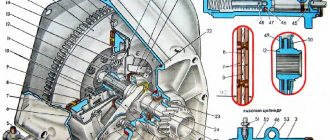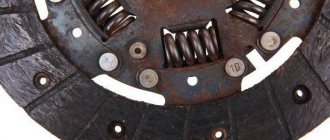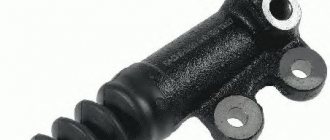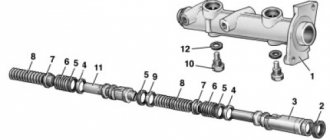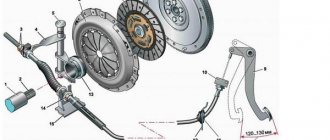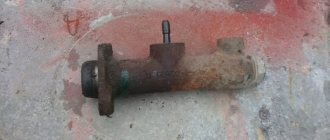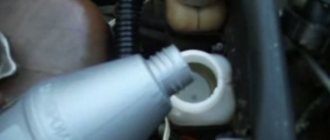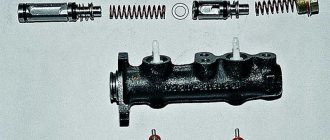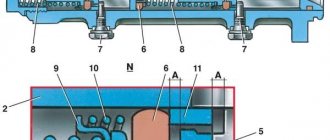Operating principle of the clutch slave cylinder
The hydraulic clutch slave cylinder receives the force imparted by the pedal to the master cylinder and, as a result of the pressure created in the pipeline, transmits it directly to the fork, which acts on the release bearing. It is an integral part of the system and is a cylindrical product attached to the clutch basket housing. A hydraulic drive tube enters it, and a rod comes out, resting on the cylinder piston on one side, and on the clutch fork on the other.
What to consider when choosing
Almost every automaker creates working cylinders exclusively for their cars. Comparing the cylinders from Ssang Yong and Nissan, you can see that they have different shapes, are mounted differently, and the first one even has a release bearing mounted on it. They also probably have different rod lengths and connections to the actuator. So you can choose the right working cylinder in three ways:
- VIN code of the car
. Contact the store and use the transport code when selecting. So you will find both the original cylinder and its analogues. There is zero chance of making a mistake; - Car data
. Their list includes body, make, engine data, year of manufacture. The year of manufacture is especially important. Even within the same line of cars, those produced in different years may have different RCS; - Old part code
. It's very simple: find out the code of the already installed working cylinder and select the same one. It is also possible that in this way you will be able to find compatibility sheets for working cylinders, which will contain the code for an existing part and identical analogues.
In general, the choice will not be difficult. However, you should not forget: even similar external parts may have different “fillings”. Collect as much information as possible, or better yet, search directly by VIN code - you won’t go wrong.
How to choose a clutch slave cylinder
When replacing the clutch slave cylinder, it is advisable to buy an original product made by the car manufacturer. If this is not possible, it is possible to install similar spare parts from a third-party manufacturer, but there is a high risk of purchasing a low-quality product. A part that has a price significantly lower than the original will quickly fail due to low-quality components and poor workmanship. This makes a cheap purchase economically unprofitable, since the need to purchase a quality product will remain.
Which one is better to put
On the VAZ 2101 it is necessary to install a hydraulic clutch designed for the VAZ 2101–07. Cylinders designed to work in UAZ, GAZ and AZLK vehicles are not suitable for installation on a “penny” car. The situation is similar with imported analogues. It will be quite problematic to introduce a GVC from any foreign car, which is due to different mounting of the unit, different threads and tube configuration. However, a hydraulic drive from a VAZ 2121 or from a Niva-Chevrolet is suitable for the “classic”.
Manufacturer's choice
Today there are many companies that manufacture clutch master cylinders. However, when choosing and purchasing the unit in question, preference should be given to the following manufacturers:
The average cost of a hydraulic clutch is 500–800 rubles. However, there are products that cost about 1,700 rubles, for example, cylinders from ATE.
Table: comparison of hydraulic clutch actuators from different manufacturers by price and reviews
| Manufacturer, country | Trademark | Cost, rub. | Reviews |
| Russia, Tolyatti | AvtoVAZ | 625 | Original GVCs are made with high quality and are more expensive than analogues |
| Belarus | Fenox | 510 | Original GVCs are inexpensive, made with high quality, and are popular among drivers |
| Russia, Miass | Brick Basalt | 490 | Improved design: the absence of a technological plug at the end of the cylinder and the presence of an anti-vacuum cuff increases the reliability of the product |
| Germany | AND THOSE | 1740 | The originals are of the highest quality. The price is tied to the EURO exchange rate |
| Germany | HORT | 1680 | Original GCS are reliable and durable in operation. The price is tied to the EURO exchange rate |
| Russia, Miass | Cedar | 540 | The original GVCs do not cause any particular complaints |
Installation or replacement
Removing or replacing the clutch slave cylinder is carried out in the following order:
- Unscrewing the pair of bolts securing the cylinder body to the clutch housing.
- Disconnecting the pusher from the clutch fork.
- Disconnecting the hose connecting the clutch slave and master cylinders.
- Plug the hose with a suitable size plug to prevent liquid leakage.
Installing a new or repaired wheel cylinder is carried out in the reverse order, after which the system is pumped to fill it with brake fluid and remove air. During assembly, a special lubricant is applied to the pusher axis, usually CASMOLY L9508.
How to replace the cuff?
So, you can repair the cuffs as follows. First, remove the working cylinder. To do this, you need to press the clutch fork with a certain force, and then, when the piston leaves, release the rod and remove it from the cylinder. Next, use a 17 wrench to loosen the nut holding the hose. Using a 13mm wrench, remove the bolts that hold the cylinder to the gearbox housing. Then completely unscrew the cylinder from the hose. Next, the already dismantled GAZelle Next clutch slave cylinder is carefully inspected. To do this, it is cleaned of dirt, and then the structure is disassembled.
The cuff should be removed using pliers. The retaining rings are removed from the groove, and then the piston is removed. If traces of oxidation or corrosion are observed on the surface of the piston, then use a solvent. After the return spring is removed, it is necessary, using a clean rag, to wipe the working part of the cylinder (the so-called “mirror”).
Next, they carefully study the cuffs themselves in the cylinder and inspect the internal parts. You should inspect it as carefully as possible to see wear, pitting, and cracks. Often one of the causes of malfunctions can be poorly manufactured parts. For example, a brake system malfunction may occur due to an incorrectly honed cylinder working mirror. Longitudinal grooves on the surface could cause wear on the cuff.
Replacing the cuff begins with pre-treating the new part with brake fluid. The piston is then installed in the cylinder and the working edges are primed. Assembly is carried out in reverse order. Upon completion of the work, brake fluid is poured into the system and the clutch is pumped to remove air.
It is necessary to take into account that new cuffs need time to grind in and break in. During this time, minor leaks may occur. It is important to constantly monitor the level of brake fluid in the system. It must be said about the cylinders for GAZelle Next that they practically do not leak. This problem has been resolved. The manufacturer installs the products.
Clutch slave cylinder malfunctions
The following signs indicate an impending repair or replacement of the clutch slave cylinder:
- A sharp decrease in the fluid level in the reservoir with characteristic spots under the car in the area where the working brake cylinder is located. Signs indicate a fluid leak due to wear on the cuffs or damage to the integrity of the hose. Eliminated by replacing worn parts and restoring the tightness of the system.
- Dips or too soft clutch pedal travel. They indicate that air has entered the system, which is eliminated by bleeding. When examining the cylinder and finding cracks or leaks on the body through which air passes, the product is partially repaired or replaced.
- Gradual sagging of the clutch pedal and problems with gear shifting, while the fluid level in the reservoir does not drop, and adjusting the pedal does not bring any results. These are signs of a broken working cylinder spring; the problem can be eliminated by replacing it.
Brand tour
The best option would be an OEM part. It fully meets all quality requirements. It will last a very long time and installs without problems. True, it costs a lot of money.
If your budget is limited, take an analogue. The best are produced by the following companies: LUK, Sachs, TWR (Germany). They are not very different from the originals. They cost significantly less. If the working cylinder of these companies is selected and then installed correctly, it will travel at least 150 thousand kilometers.
Inexpensive analogues are offered by these companies: JP Group (Denmark), Profit (Czech Republic), ABE (Poland). The quality is inferior to both the originals and more expensive analogues from the same LUK. However, you will still save money even if you replace it faster.
Repairing the clutch slave cylinder using a repair kit
Repairing the clutch slave cylinder begins with disassembling it. To do this, it is placed in a vice for convenience, after which the work is carried out in the following order:
- Removing the protective cap with the pusher, removing the piston and removing the retaining ring from it.
- Removing the sealing rings and spring from the piston.
- Cleaning all holes in the cylinder and the air outlet fitting.
- Inspection of the cylinder mirrors and the outer surface of the piston for mechanical damage.
- Flushing all parts and surfaces with brake fluid. The use of other solvents for this purpose is prohibited.
- Installation of parts of the repair kit, which includes a spring, a protective cap and piston o-rings.
- Cylinder assembly.
Adjusting the stroke of the clutch fork pusher
To do this, use pliers to disconnect the tension spring from the fork. Then the spring is completely removed. Next, use a ruler or square to measure the free play. The square is placed so that it can rest against something.
When the element is installed correctly, press the fork forward until it stops and fix it in this position. Next, remember the position of the square relative to the fork. The latter is released and the free movement is checked. If it is less than the passport norm, then the plug is adjusted again.
First of all, you need to hold the adjusting nut with one wrench. Use the second wrench to loosen the locknut. Next, pliers are used to secure the pusher from turning. Then the locknut is loosened and the correct free play of the fork is achieved by rotating the adjusting nut. If everything is correct, the pusher is again held with pliers and the locknut is tightened.
Bleeding the clutch slave cylinder
After installing the working cylinder in place, it is pumped as follows:
- Fill the master cylinder reservoir with brake fluid.
- A tube with the other end lowered into a container with brake fluid is connected to the air bleeder fitting of the working cylinder, which has been previously unscrewed ¾ of a turn.
- Repeatedly press the clutch pedal until air bubbles stop appearing from the tube, after which, with the pedal pressed all the way down, the fitting is screwed in.
- Disconnect the hoses and check the fluid level in the tank, which is topped up if necessary.
The described actions make it possible to eliminate the malfunction of the working cylinder of the clutch of all models of the VAZ: 2101, 2102, 2103, 2104, 2105, 2106, 2107, 2108, 2109, 21099, 2110, 2111, 2112, 2113, 2114, Niva, Priora, Starine, Grant, Grant. Vesta and most foreign cars.
About the causes of cuff malfunctions and how to eliminate them
Among the reasons may be leaks of working fluid due to depressurization, contamination in the hydraulic system, airing, loss of performance characteristics of the working fluid. If such problems are observed and they are related to the brake fluid, then everything can be solved by replacement and bleeding.
More difficult to solve are problems associated with leakage. Often, depressurization occurs due to wear of the seals. First of all, you need to check if there is a leak.
Popular models and manufacturers
When choosing a non-original clutch slave cylinder, products from the following manufacturers are most often used:
- Sachs. The German company is a leading manufacturer of clutch cylinders for most automobile brands of foreign and domestic manufacturers. The popularity is due to the high quality of products and the use of innovative developments.
- Lukas. The largest manufacturer of auto parts, whose products meet all international quality standards. It produces brake cylinders for most automobile brands and repair kits for them.
- Fenox. Specializing in the production of clutch and brake cylinders for more than 25 years. Supplies products to most automakers.
- TRW. The company owns the Lukas brand and supplies brake system components, in particular brake cylinders, for all the world's largest automakers. The products are distinguished by their quality and extreme reliability.
- LUK. Official partner of major automakers in terms of designing new developments and systems. Supplies clutch cylinders to assembly lines of most of the world's major automakers.
What's next?
To bleed, unscrew the cap of the expansion tank. Next, liquid is drawn into the syringe and the air is expelled from it. The hose is connected to the valve at one end, and to the syringe at the other. Unscrewing the valve with a key, press on the syringe and inject liquid. Next, without removing the hose, tighten the valve so that no air gets into it. After this, you need to sit in the cabin and create pressure in the system. To do this, press the clutch pedal several times (but not less than five or six). Then we go under the hood and smoothly unscrew the valve.
If the hose is transparent, you will see airy liquid coming out of it. At the same time, its level in the expansion tank will drop. We need to support him. Therefore, fill in new brake fluid again to the maximum mark. Then the procedure is repeated again. They sit back in the cab and create pressure in the clutch system by pressing the pedal several times. Then unscrew the valve and look at the condition of the liquid. There should be fewer bubbles. The procedure is repeated until the air is completely removed from the system (this is why it is so important to use a transparent hose).
